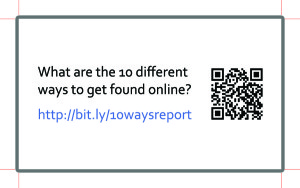BBH Feature: How to Easily Capture Offline Leads into Your Online Marketing Systems
Before I get started with the article, we’re hosting a free webinar: “How to Capture Offline Visitors to Online Leads” on Wednesday, January 13, at 9:00 a.m. PST/12:00 noon EST.
Be sure to register for it so you can hear more about this topic live! Getting people in an offline world to interact and engage with you online is a challenge for most business owners. How can you quickly and easily create a system that people can use in your offline marketing materials that instantly converts them to online leads? Discover how to generate QR codes that work, and how to measure them effectively using the tools you already have at hand.

If you’re using offline marketing to generate leads, you need to get visitors to your online systems easily and quickly. Use QR codes to get people to your lead magnets quickly without the visitor having to type anything into their phone.
Many small business owners do all kinds of offline marketing to generate leads for their business.
This can include a variety of activities like attending chamber mixers, networking events, or having a booth at a trade show.
During any of these types of events, you’ll likely be passing out business cards, flyers, and have other static marketing material like pop-up banners and so on.
Maybe you even have some ads running in the local newspaper.
With this type of collateral, however, you have several challenges:
- How do you get people from these offline marketing materials into your online world quickly and easily?
- How can you measure if people are coming to your online systems from the offline materials?
- How can you test to see if one is more effective than another?
If you do any kind of marketing, especially if you’re spending money on it, you have to test things, measure them, and make sure whatever you’re doing is working properly, or you’re wasting your time and money.
In the USA, as of April 2015, nearly 2/3 of us own a smart phone, and that number is going up each year.
That means that those folks should be able to get to your website from their phone (is your website mobile-aware?).
However, most of us don’t want to type in a web address to get to something on our phones. It’s awkward and fraught with the risk of typos. This just leads to frustration.
You can use a shortened URL like bit.ly, but that only partially solves the problem.
Quick Response Codes
Instead, by using a quick response code or QR code, people with a smart phone can instantly scan your code and get to wherever you want them to go.
They are extremely easy to generate, and you can make them point to any web address you want.
By using a QR code reader, the visitor doesn’t have to type anything into their phone or do anything but point their phone at the code. It will automatically take them there in their browser.
 QR codes are very forgiving too.
QR codes are very forgiving too.
Even if it’s damaged or not clear, there is error-correction built in so that it can still be scanned.
The image to the right here is from Wikipedia, and demonstrates that it still works, even though a chunk of the code is missing (it just takes you to Wikipedia by the way).
Where Can You Use QR Codes?
The possibilities are endless, but some places I’ve used them include:
 The back of my business cards (here’s the back of mine)
The back of my business cards (here’s the back of mine)- Pop-up banners at networking events and tradeshows
- Printed newsletters
- On printed flyers
- Window banners
The key here is to make sure that the QR code takes the visitor to a page that encourages them to enter their name and e-mail address to get something valuable.
You don’t necessarily just want to take them to your website home page.
Instead, take them to a conversion tool to sign up for your newsletter or some other lead magnet that gets them into your marketing system.
By the way, don’t put QR codes on your website! This is a mistake I see sometimes.
If someone is looking at your website, they’re not going to whip out their phone to scan it. They’re already there.
Worse, if they’re already on their phone looking at your website, they can’t scan it. Just give them a link or a button to take them to the next step.
How Can You Measure The Effectiveness of Them?
The cool thing about QR codes is that they are really just a graphical version of a 301-redirect.
They function exactly like a shortened link, like bit.ly or tinyurl.com. When the QR code is scanned, it’s translated into a URL and takes the visitor there.
So you can make ANY URL a QR code.
By using Google’s link tagging tool, you can tag the links to track in Google Analytics so you can see exactly what’s working or not working, and where people are scanning them from.
You can tag flyer #1 with one tag, and another flyer with a different tag, and in Analytics see which one is converting better.
Come to our free webinar on January 13, and we’ll show you how to quickly create tagged QR codes that allow you to measure your collateral marketing materials in Google Analytics.
In less than 60 seconds, you can tag the URL and create the QR code.





Tom, I think your ideas on how to use QR codes are terrific. But, are people really buying in to them? I feel like I’m seeing less and less usage of QR codes in marketing materials. Usually in marketing the more something works the more you’ll see people using them. Case in point, video marketing is on a tear. If you have some further info on peoples’ willingness to scan QR codes, I’d love to see it. Thanks!
Hi Michael, It’s true that QR codes are less than ideal. Maybe only 50-60% of smart phones have an app installed (I don’t know why they don’t include it as a default functionality). But I have not found any other way to get offline leads to an online page. So no, conversion rate isn’t great, but it’s an opportunity for people to get into your systems without having to type some URL in.